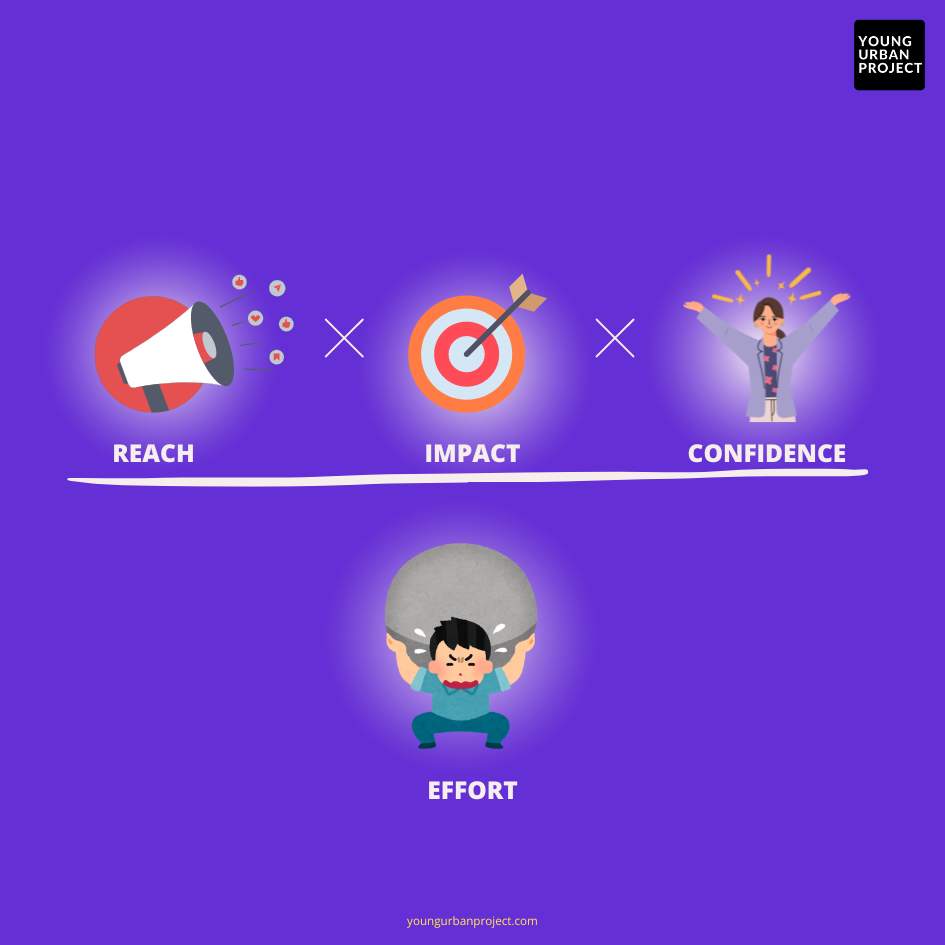The RICE scoring model is a prioritization framework used to evaluate and prioritize tasks, projects, or features based on their potential impact and feasibility. RICE is an acronym that stands for Reach, Impact, Confidence, and Effort, which are the four key factors used to assess the viability of a project or task. This framework is widely used by product managers, marketers, and content writers to prioritize their tasks and projects effectively.
Table of Contents
Breaking Down the RICE Acronym
The RICE acronym is composed of four key factors that are used to evaluate the potential of a task or project. Here’s a breakdown of each factor:
- R: Reach: The Reach factor assesses the potential audience size and the number of people who will be affected by the task or project. This factor is critical in determining the potential impact of the task or project. For example, if a task is expected to impact a large number of users, it will score higher on the Reach factor.
- I: Impact: The Impact factor evaluates the potential impact of the task or project on the business or users. This factor assesses the potential benefits of the task or project, such as increased revenue, improved user experience, or enhanced customer satisfaction. For example, if a task is expected to drive significant revenue growth, it will score higher on the Impact factor.
- C: Confidence: The Confidence factor assesses the level of confidence in the task or project’s ability to achieve its goals. This factor evaluates the uncertainty and risk associated with the task or project. For example, if a task is well-researched and has a clear plan, it will score higher on the Confidence factor.
- E: Effort: The Effort factor evaluates the complexity and feasibility of the task or project. This factor assesses the resources required to complete the task or project, such as time, budget, and personnel. For example, if a task is simple and requires minimal resources, it will score higher on the Effort factor.
How to Use the RICE Scoring Model Framework?
Using the RICE framework is relatively straightforward. Here’s a step-by-step guide to get you started:
- Identify the tasks or projects: Using the RICE scoring model, decide which tasks or projects to prioritize.
- Assign scores: Assign a score to each task or project based on the four factors: reach, impact, Confidence, and Effort.
- Calculate the RICE score: Multiply the scores together to get the total RICE score.
- Prioritize: Prioritize the tasks or projects based on their RICE score.
Also read: How to Answer Behavioral Questions in Product Interviews
The RICE Scoring Model Formula

The RICE scoring model works by assigning a score to each task or project based on the four factors: Reach, Impact, Confidence, and Effort. Each factor is scored on a scale of 1-10, and the scores are then multiplied together to give a total RICE score. The higher the score, the higher the priority of the task or project.
Scoring the Four Factors
Each factor is scored on a scale of 1-10, with 1 being the lowest score and 10 being the highest score. The scores are then multiplied together to give a total RICE score. The task or project has a higher priority the higher the score.
Calculating the RICE Score
The four-factor scores are multiplied together to determine the RICE score. The formula for calculating the RICE score is:
RICE Score = (Reach x Impact x Confidence) / Effort
For example, if a task has a Reach score of 8, an Impact score of 7, a Confidence score of 9, and an Effort score of 6, the RICE score would be:
RICE Score = 8 x 7 x 9/ 6 = 84
Interpreting the RICE Score
The RICE score is a relative score that helps teams prioritize tasks and projects. It is not an absolute measure of a task or project’s potential but rather a way to compare the potential of different tasks and projects.
Example of RICE Scoring Model
Let’s consider an example of how the RICE scoring model works. Assume Task A and Task B are our two tasks.
Task A: Create a new blog post on a popular topic.
- Reach: 8/10 (the blog post will reach a large audience)
- Impact: 7/10 (the blog post will drive moderate traffic and engagement)
- Confidence: 9/10 (the blog post is well-researched and has a clear plan)
- Effort: 6/10 (the blog post requires moderate resources and time)
Task B: Launch a new product feature.
- Reach: 9/10 (the product feature will reach a large audience)
- Impact: 9/10 (the product feature will drive significant revenue growth)
- Confidence: 8/10 (the product feature is well-researched and has a clear plan)
- Effort: 5/10 (the product feature requires significant resources and time)
Using the RICE scoring model, we can calculate the total RICE score for each task:
Task A: 8 x 7 x 9 / 6 = 84
Task B: 9 x 9 x 8 / 5 = 129.6
Based on the RICE scores, Task B has a higher priority than Task A.
Benefits of the RICE Scoring Model
The RICE scoring model offers several benefits, including:
- Improved prioritization: The RICE scoring model helps teams prioritize tasks and projects more effectively, ensuring that they focus on the most impactful and feasible projects.
- Increased productivity: By prioritizing tasks and projects based on their potential impact and feasibility, teams can increase their productivity and deliver more value to users and customers.
- Better decision-making: The RICE scoring model provides a data-driven approach to decision-making, ensuring that teams make informed decisions about which tasks and projects to pursue.
Common Challenges and Solutions
While the RICE scoring model is a powerful tool for prioritizing tasks and projects, it’s not without its challenges. Here are some common challenges and solutions:
- Subjective scoring: One of the common challenges of the RICE scoring model is that the scoring can be subjective.
Solution: Ensure that the scoring is based on data and objective criteria. - Complexity: The RICE scoring model can be complex, especially for large projects or tasks.
Solution: Break down the project or task into smaller components and prioritize each component separately. - Limited resources: The RICE scoring model assumes that resources are available to implement the task or project.
Solution: Consider the availability of resources when scoring the task or project.
Overall, the RICE scoring model is a powerful tool for prioritizing tasks and projects. By understanding how the model works and applying it effectively, teams can improve their prioritization, productivity, and decision-making.
Best Practices of the RICE Scoring Model
Here are some best practices for using the RICE scoring model:
1. Use Reliable Data: Base your Reach, Impact, Confidence, and Effort estimates on solid data and analytics. This will help ensure that your scores are accurate and reliable.
2. Be Realistic: Avoid overly optimistic or pessimistic estimates. Set attainable, realistic goals in order to guarantee precise prioritization.
3. Regularly Review Estimates: Periodically revisit and adjust your estimates as new information becomes available or as projects progress.
4. Involve Cross-Functional Teams: Engage different teams (e.g., marketing, development, sales) to provide diverse perspectives and improve the accuracy of your estimates.
5. Align with Strategic Goals: Ensure that the projects prioritized using the RICE framework align with the overall strategic goals of the organization.
6. Use a Consistent Scoring Scale: Use a consistent scoring scale across all projects and tasks to ensure that scores are comparable.
7. Consider Multiple Scenarios: Consider multiple scenarios and outcomes when estimating Reach, Impact, Confidence, and Effort.
8. Use the RICE Scoring Model in Conjunction with Other Prioritization Frameworks: Use the RICE scoring model in conjunction with other prioritization frameworks, such as the Eisenhower Matrix or the MoSCoW method, to create a more comprehensive prioritization framework.
9. Document Assumptions: Clearly document the assumptions behind your estimates to maintain transparency and facilitate future reviews.
10. Continuously Monitor and Adjust: Continuously monitor the progress of projects and adjust the RICE scores as necessary to ensure that priorities remain aligned with changing circumstances.
Conclusion
Overall, the RICE scoring model is a powerful tool for prioritizing tasks and projects. By understanding how the model works and applying it effectively, teams can improve their prioritization, productivity, and decision-making.
The RICE scoring model is a powerful prioritization framework that can help teams and individuals prioritize tasks and projects more effectively. By understanding how the RICE scoring model works and how to use it, you can make informed decisions about which tasks and projects to pursue, and drive more value to users and customers. Remember to use data-driven scoring, involve multiple stakeholders, and review and revise the priorities regularly to get the most out of the RICE scoring model.

